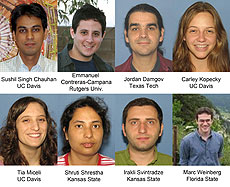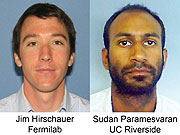Creating dark matter
 |
Studying the dark matter conundrum is like a three-legged stool. While clear observation of the dark matter in the Milky Way by detectors in deep underground mines will be necessary, we won't understand the nature of dark matter until we can make it and study it at will.
|
Galaxies spin too fast. According to the familiar laws of gravity and inertia, they should tear themselves apart when rotating that quickly, as the gravity generated by the visible matter would be unable to hold them together. Galaxies have existed for billions of years, so we have a paradox. The leading explanation for this apparent impossibility is that dark matter exists. Dark matter is electrically neutral, which is why it can't be seen, and massive, which is why it affects the gravity of galaxies.
Dark matter, if it exists, is like a cloud of stable subatomic particles centered on galaxies like our Milky Way. Because of its neutral nature, it can pass through ordinary matter in much the same way that neutrinos do. If it does exist, dark matter is passing through you right now, essentially without interacting at all.
If dark matter interacts via the weak nuclear force, an occasional dark matter particle will bounce off an atom. This is how scientists try to directly detect dark matter. Physicists place their detectors in deep mines to shield them from the incessant rain of cosmic rays. In order for the detectors to work, they are cooled until the atoms are nearly stationary. That way, when a dark matter particle hits a stationary atom, we will see it: the detector will ring (figuratively) like a bell.

These researchers contributed to this analysis.

These two physicists acted as Hadron Calorimeter operations managers, coordinating daily activities during data taking to ensure the proper operation of HCAL and a quick response to any HCAL-related issues.
We can learn about dark matter through methods other than direct detection. If it exists in space, then occasionally two dark matter particles will hit each other and annihilate. We would then be able to see the results of that annihilation in space-based detectors. This is termed indirect detection of dark matter.
However, observation is not the same characterization. In order to really understand the nature of dark matter, experiments like CMS will search for collisions with dark matter's characteristic signature. By exploiting the simple principles of energy and momentum conservation encountered in an introductory physics class, we observe missing energy, which could be the signature of dark matter particles produced in the collision and then escaping the detector. The CMS team recently submitted for publication the results of a search for dark matter and set a limit on the kinds of dark matter that the LHC can produce.
The three approaches – direct, indirect and collider experiments – are like a three-legged stool. Only with all three legs will we finally understand why our galaxy exists.
—Don Lincoln
|